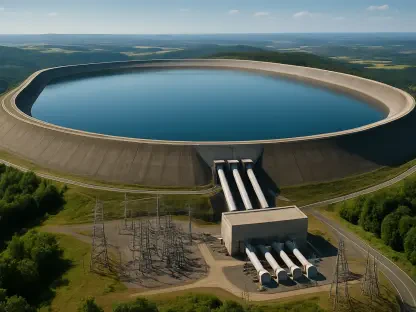In today’s interview, we have the pleasure of speaking with Christopher Hailstone, an expert in energy management, renewable energy, and electricity delivery. Christopher brings a wealth of knowledge in understanding grid reliability and security, especially in the context of groundbreaking projects in renewable energy. Our discussion will delve into China’s ambitious undertakings in wind and solar energy, the global implications of these projects, and the challenges faced in the offshore wind sector.
Could you provide an overview of China’s current wind and solar projects under construction?
China is currently steering a monumental endeavor in renewable energy, with 510 GW of solar and wind projects under construction. This reflects a significant portion of the global planned projects, emphasizing China’s role as a leader in renewable energy development. The scale of these constructions not only showcases China’s commitment but also promises to reshape the global energy landscape.
How does China compare to other countries in terms of planned wind and solar projects globally?
China’s capacity underlines its unparalleled dominance in the sector, with 29% of all planned global projects and 74% of those under construction. This immense scale highlights China’s strategic investments and its commitment to transitioning from traditional thermal sources to cleaner energy alternatives, setting a benchmark for other nations to follow.
What specific progress has China made in terms of solar capacity under construction, and how significant is this?
Currently, China is working on 709 GW of solar capacity, with 287 GW actively under construction. This progress not only underscores the nation’s rapid expansion in solar technology but also highlights its significant investment in establishing a sustainable and renewable energy framework, essential for meeting future energy demands.
Can you explain the current status of China’s wind capacity projects, especially those under construction?
In terms of wind energy, China is on a robust growth trajectory, with 593 GW planned and 223 GW under construction. This commitment to wind power complements the solar projects, creating a balanced and diversified renewable portfolio that supports China’s environmental objectives and electricity needs.
How has China’s operating solar and wind capacity changed recently, particularly with the additions in 2024?
By 2024, China had amplifying its solar and wind capacity by adding a record 357 GW, further reinforcing its position as a renewable energy powerhouse. These additions include significant projects such as large-scale photovoltaic plants, which collectively contribute to a more sustainable energy grid.
Could you tell us more about the Midong solar farm in Xinjiang Autonomous Region and why it’s significant?
The Midong solar farm, a 3.5-GW facility, stands as a testament to China’s ambition and technological capability. As the world’s largest single-site PV plant, it plays a critical role in advancing China’s solar energy production and serves as a model of efficiency and scale in renewable infrastructure.
What percentage of the world’s operating utility-scale solar and wind capacity does China account for, and what does that mean for global energy trends?
China holds 44% of the global operational utility-scale solar and wind capacity, a fact that underscores its influential role in driving global energy trends. This footprint not only marks a shift in energy sources but also indicates the potential for a global transition towards more sustainable energy practices.
How has China managed to exceed its thermal capacity with wind and solar energy, and what impact has this had on its electricity consumption?
By the first quarter of 2025, China’s wind and solar capacity surpassed its thermal capacity, marking a pivotal shift in its energy consumption. This transition, which raised the share of renewables to nearly 23% of its electricity needs, represents a strategic move toward more sustainable energy utilization, reducing reliance on fossil fuels.
What trends and developments have you observed in China’s offshore wind sector since 2018?
Since 2018, China’s offshore wind capacity has experienced remarkable growth, expanding from under 5 GW to 42.7 GW in 2025. This rapid expansion reflects the strategic importance of offshore wind in China’s renewable strategy, fueled by technological advancements and increased demand for cleaner energy.
What challenges has China faced in advancing its offshore wind capacity, and how is it addressing them?
While China’s offshore wind sector is growing, it hasn’t been without challenges. These include technical hurdles, environmental considerations, and logistical complexities. China is addressing these issues through strategic planning and coordinated efforts across various provinces, signifying a collaborative approach to overcoming obstacles.
What role do coastal provinces play in advancing offshore wind capacity in China, and why is this important?
Coastal provinces are pivotal due to their geographic advantage and industrial needs. Their progress in offshore wind capacity is crucial for meeting energy demands and decarbonizing industrial sectors. These regions highlight a focused effort to meet national and regional energy goals, facilitating the broader adoption of renewables.
Can you elaborate on Mengqi Zhang’s statement regarding China’s potential to displace emissions from fossil fuels along its industrial coast?
Zhang’s insights highlight China’s coastal areas as critical zones for reducing fossil fuel dependency. By expanding wind and solar projects in these regions, China can significantly curb emissions, fostering a cleaner industrial landscape and promoting a sustainable economic model for others to emulate.
What is the future outlook for China’s offshore wind projects, especially those in the pipeline, and what are the next steps for their progress?
China’s future in offshore wind looks promising, with 67 GW in development and 28 GW under construction. The next steps involve enhancing grid infrastructure, fostering innovation, and establishing policies that support long-term growth. This framework will help sustain momentum and ensure further advancements in offshore wind capabilities.









